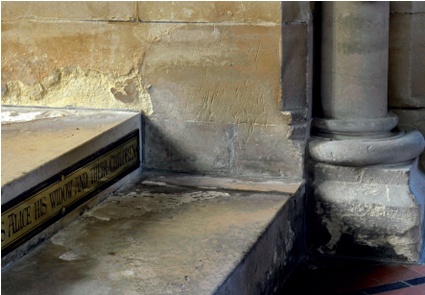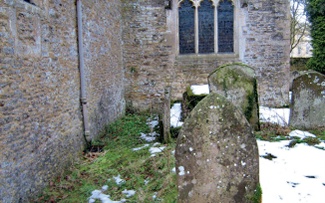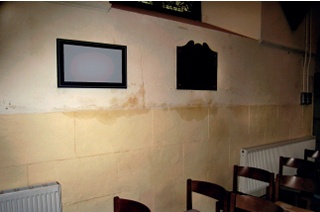Damp Movement in Rubble Walls
Tim Floyd
 |
|
| Typical damp at the base of a church wall, resulting in crystallisation damage to the ashlar masonry |
This subject is one of many in the field of building science that tends to get oversimplified. It could be argued that this is perfectly reasonable when the subject matter is wet walls as opposed to rocket science. However, the last 30 years has seen the publication of a large volume of research on the properties of building materials and systems. Given the tendency to oversimplification on the one hand and the mass of scientific data available on the other, it is important to get to grips with the relevant factors at play in a specific case.
Any discussion about water in wall bases must include a comment on terminology, above all the term ‘rising damp’. Some commentators see the term as legitimate (water is rising up the wall, what else would you call it?). However, the problem in this case is that the term (like many others in the field of building science) has come to be used as a generic catch-all and has developed a (very unhelpful) life of its own. Furthermore, misdiagnosis is common: damp at the base of a building is far more likely to come from leaks at roof level (for example, due to failed roof coverings and flashings, overflowing gutters or deteriorating chimneys) and from rain penetrating through walls above.
A general rule of thumb is that water enters masonry in four ways:
- through its base as a result of its relationship or equilibrium with the ground on which it stands
- from above via vulnerable wall-heads and defective roof drainage
- laterally from the exterior as a result of severe rain exposure
- internally from condensation (often as a consequence of one or all of the above).
This article focusses on the first process – specifically with regard to those solid and rubble stone walls generally associated with churches – although all four processes are often interrelated.
WATER SOURCES
Before determining whether groundwater is contributing to a problem, first consider the geology and location. The geological formations required to produce a direct connection between any foundation and the watercourse are relatively rare. In most cases sub-soil drains moisture away from the surface, although some may drain more slowly than others. Churches sited on clay soils will be more susceptible to problems caused by broken drains or badly controlled surface water than those sited on gravel, for example. As a result a church in Norfolk (on chalk) close to land drains would have to be looked at in a different light to one in London (on predominantly clay).
This is not to say that fluctuation in groundwater levels can be totally discounted. Conditions vary with annual rainfall, and the British Geological Survey has produced a groundwater timeline which demonstrates the variability in water table levels in various parts of the country since 1970.
One diagnostic tool routinely used over the last few years to distinguish surface water from groundwater (or subsurface water) is outlined in the Building Research Establishment’s Digest 245 Rising Damp in Walls: Diagnosis and Treatment. Very briefly, its premise is that water which has moved through the ground (unlike surface water) will have had the opportunity to take various soil minerals into solution – something which can be established by a relatively simple test. However, it is only in exceptional circumstances that the movement of sub-surface water up through wall foundations and bases is likely to be the principal problem, so such tests are rarely required.
So if water is managing to rise up through the wall bases, it is generally water which has collected on the surface and found its way into the wall bases. In this case surface water is taken to include that collected by the rainwater goods and, if they are functioning properly, discharged away from the building.
HISTORICAL FACTORS
To understand why there seems to have been a relatively recent increase in incidences of excessive damp in the bases of church walls and their related floor junctions, one must look to the congregation, or rather their unfortunate migration from the church maintenance team to the surrounding graveyard.
Churches are not necessarily complex structures, but they are usually big (and sometimes extremely big), making access to and maintenance of concealed parapets, valleys and hoppers perilous and maintenance of drainage runs physically arduous.
The phenomenon of graveyard rise is widespread and well-known. Combined with periodic maintenance work to dig out drainage channels around the outside of the church and any natural settlement of the building, the increase in levels of the surrounding graveyard can effectively place the church in a depression (illustrated below) that collects water.
Generally, the older the church and the more built up its surroundings, the greater the problem which can result from an increase in adjacent ground levels, particularly where impervious road and pavement surfacing expose the fabric to run-off.
 |
|
| Above left: water confined in a capillary forms a concave upper surface or ‘meniscus’. The water travels up the capillary because the adhesion of the water molecules to the capillary walls is stronger than the cohesion between them. Similarly, water droplets cling to a leaf because the adhesion of the water molecules to the surface of the leaf is stronger than the cohesive forces between the water molecules. | |
SCIENTIFIC PRINCIPLES
To consider the movement of water in masonry it is necessary to briefly touch on the following scientific principles (each is a subject area in its own right so only brief, simplified definitions are given here):
POROUS BUILDING MATERIALS
The porosity of a material is defined by the ratio of area occupied by its pores to its total crosssectional area. All building materials are porous to some extent, with pores forming either continuous networks or closed systems. The principle of pore formation in building materials is similar whether they are man-made or naturally occurring. When water is trapped and then driven out, usually by heat, voids are left behind (brick production is a good example).
Plasters and mortars have well-developed pore structures by default, as high volumes of water (which will eventually evaporate) must be added to make them sufficiently workable.
Pore space geometry and characteristics
Porosity in natural building stone is a little more complex, although a rule of thumb is that rocks generally become less porous with age and depth of burial. Consolidation of all rock types (by heat and/or pressure) can produce complex dual porosities with open and closed systems. Stones with well-sorted grains tend to produce very coherent pore networks which enable efficient hydraulic transport.
A material with a high porosity ratio isn’t necessarily going to be conducive to effective hydraulic transport. A brick fired at high temperature will have large pores within the clay body, but the formation of a fireskin effectively closes off many of the pore openings at the surface.
The heterogeneous nature of naturally occurring building stones makes them more difficult to categorise as the pores often contain crystalline deposits which affect their porosity. This phenomenon is also seen in mortars, with complex crystal growth within the pore structures of both lime and cement-based compounds.
Pore networks constitute effective capillary networks.
Capillary action
The process which ultimately defines how water is able to move against gravity is capillary action. Although this is not the most complex scientific field, it is interesting to note that capillarity was the subject of Albert Einstein’s first paper, submitted to Annalen der Physik in 1901.
Capillary movement of water (illustrated above) occurs in a narrow tube because the adhesion of the water molecules to many solid objects is stronger than the cohesive forces between them (this is why the water droplets in the photograph above are sticking to the leaves). Surface tension is a product of inter-molecular cohesion. Water confined in a small tube or capillary results in the formation of a concave upper surface or ‘meniscus’ (from the Greek for crescent). The smaller the tube diameter, the greater the ratio of circumference to area and the more efficient the capillary action.
The height to which water is able to move in a capillary is therefore limited by its surface tension, the size of the capillary and the effects of gravity.
Understanding how and why water molecules behave in this way, is fundamental to an appreciation of how moisture behaves both inside and on the surface of building materials.
There are many other factors which affect the movement of water (in both liquid and gaseous phases) in capillaries, such as moisture storage characteristics, vapour and capillary transport coefficients, vapour diffusion and effusion in micro pores, sorption and adsorption isotherms. These and other factors are of specialist interest only and so are not expanded upon here.
IN PRACTICE
Some churches have exposed stone walls internally and some of these buildings have problems associated with low-level damp and/or the crystallisation of mineral salts (which may be the reason why the plaster was originally removed). Most churches, however, are plastered internally so the discussion below deals exclusively with them.
Wall construction
 |
|
| The rising ground level in this church graveyard, perhaps in combination with other factors, has created a depression along the foot of the exterior walls encouraging water to collect in this vulnerable area. |
The scientific principles touched on above would generally have been appreciated (in a practical rather than an academic sense) by the surveyors and masons originally responsible for the construction of a church. They did not have the benefit of hindsight with regard to the use of some stones that have proved especially prone to weathering, particularly those damaged by the products of the industrial revolution.
In general, however, they demonstrated a good appreciation of the importance of collecting and discharging surface water clear of the building. (It could be argued that the principle of effective building design and informed material sourcing is a large part of what makes any building historic in the first place.)
Consider the rubble stone construction found in many historic churches, which has a central core containing smaller stones and fragments of mortar. Originally the building would have been internally plastered in lime and its solid floor would probably have been covered in flagstones.
Where rising or penetrating damp is suspected, the investigating surveyor should expect to find plaster separating from the masonry and/or possibly a visible tide mark. (If the wall coverings were structurally stable with no obvious tide marks or signs of water ingress at the wall/floor junction and the damage limited to disruption of the decorative surface, condensation would be the likely cause.)
Determining the nature of the wall covering is important. Usually a hard cementitious plaster is quite distinct from one which is lime-based, although this is not always the case. A very simple method to distinguish the two is to drop the sample into a weak acid with around six per cent acidity – household vinegar would suffice. Both will react, although the reaction of the lime with the acid will be much stronger. Typically, if there is a problem, the internal plaster is Victorian or later and usually cementitious. Establishing plaster type will be very informative and in some situations, such as the wall shown below, it is quite clear where the cementitious ends and the lime plaster begins.
Any central core will have a high proportion of air voids which do not produce effective capillary networks. Within the masonry on either side of the core there may be a coherent capillary network for perhaps two or three courses of stonework, depending on the type of stone and mortar used and the extent of the water problem externally. Plaster applied to the internal face of the masonry provides a much more effective capillary network.
Lime plasters are both highly porous and vapour permeable. As such, any moisture from wet masonry is transported by capillary action laterally (and efficiently) to the evaporation zone (usually the internal environment). After a relatively long period the plaster will separate from the wall due to crystallisation of salts and will need replacing.
 |
|
| A church wall which has been partly cement-rendered, forcing moisture to rise by capillary action at the interface |
This could pose a problem for medieval wall paintings, but generally the plaster at the base of the wall will have been replaced many times in this zone over the centuries.
However, from the 19th century onwards, use of cement-based plasters became the norm. The pore structure and chemistry is very different to that of lime-based plasters. As a result the wall will either begin to dry preferentially to the external environment or respond in a similar way to that shown in the photograph to the left, using the interface between the plaster and the internal face of the wall to rise by capillary action higher than it would normally be able to.
Various processes, most commonly the formation of salt crystals, are likely to eventually cause cracking and separation of large portions of cementitious plaster from the damp or wet masonry.
SOLUTIONS
The base of a church wall is in equilibrium with the ground on which it is sited. If the ground is wet it may be possible to improve the situation with effective drainage. However, this will be a slow process, if successful at all.
To achieve acceptable internal wall finishes within a church which has damp or wet wall bases, the approach must be to allow any system to transmit water out of the masonry as efficiently as possible – managing rather than blocking any movement of water.
A very wet wall base will elevate the relative humidity of the internal environment. Care should therefore be taken to avoid placing timber objects directly in contact with damp walls and delicate organic materials such as papers and fabrics may be at risk of damage. The problem can be exacerbated if there is a change in the heating regime, as improvements in heating are usually associated with increased moisture movement by convection.
As with most tasks in building conservation, the control of rising damp is one where expectations must be managed.



